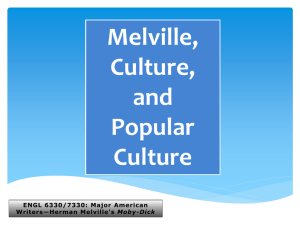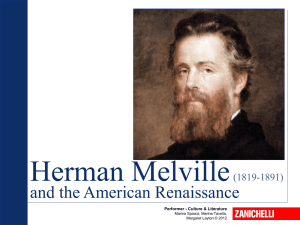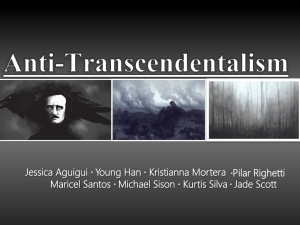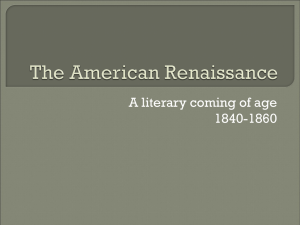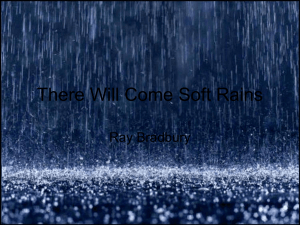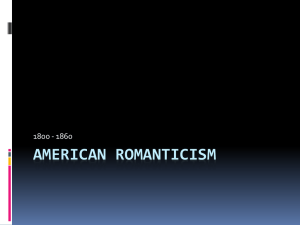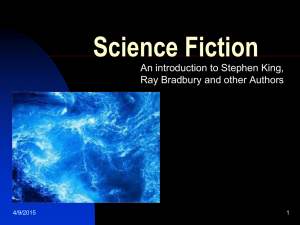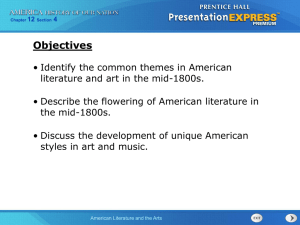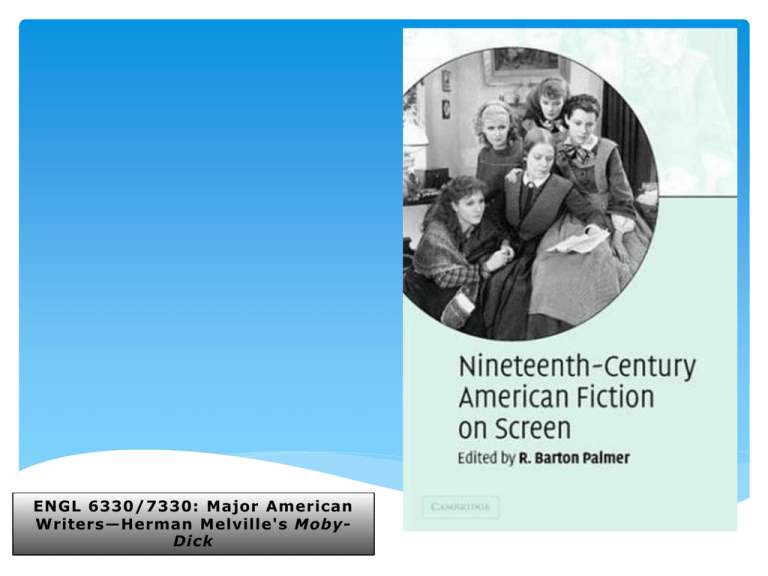
ENGL 6330/7330: Major American
Writers—Herman Melville's MobyDick
Melville’s Moby-Dick and Hollywood
Investigating the “erotics of reading” in The Pleasure of the Text (1975), Roland
Barthes once pondered why “we do not read everything with the same intensity
of reading,” why “our very avidity for knowledge impels us to skim or to skip
certain passages (anticipated as ‘boring’) . . . (no one is watching) descriptions,
explanations, analyses, conversations.” Of course, no author, Barthes concedes,
can predict in advance what will be skipped:
he cannot choose to write what will not be read. And yet, it is the very
rhythm of what is read and what is not read that creates the pleasure of the
great narratives: has anyone ever read Proust, Balzac, War and Peace, word
for word? (Proust’s good fortune: from one reading to the next, we never
skip the same passages.)1
1 Roland Barthes, The Pleasure of the Text, trans. Richard Miller (New York: Hill and Wang, 1975), pp.
10–11; italics in original.
ENGL 6330/7330: Major American
Writers—Herman Melville's Moby-Dick
Certainly, no two readers of Moby-Dick (1851), nor the same reader reading
subsequently, nor two screenwriters preparing, forty years apart, to adapt the
classic novel by Herman Melville (1819–91) for the film medium, skip the same
passages or discover the same text. Moby-Dick, after all, is full-to-overflowing
with “descriptions, explanations, analyses, conversations” inviting anything but
the avid, easily bored student, the supposedly disinterested but often with an
ax-to-grind scholar, and the medium-determined and cost-driven screenwriter to
pass on by. But it is by no means certain, as with Remembrance of Things Past,
that Melville’s text has been the beneficiary of these lapses. There are few great
books more often misread or maladapted.
ENGL 6330/7330: Major American
Writers—Herman Melville's Moby-Dick
Adapting Moby-Dick
Soon after the release of The Scarlet Letter (Roland Joffe ́, 1995), a film featuring
Demi Moore as Hester Prynne that perverted Nathaniel Hawthorne’s original
novel by supplying a happy ending, a cartoon appeared in the New Yorker that
speculated on what might happen if she were to star in a new version of
another classic novel of the American Renaissance. Over a caption which reads
“Demi Moore’s Moby Dick,” we see the actress standing, like a competitor at a
fishing contest, beside her prize catch: a giant, dead, white whale, hanging from
a hook. So far, the Moore version of Melville’s classic novel Moby-Dick (1851) has
not yet been made, but we need not wait for a movie Moby-Dick with a happy
ending.
ENGL 6330/7330: Major American
Writers—Herman Melville's Moby-Dick
Two early twentieth-century incarnations of Melville’s book, both from Warner
Brothers, the silent Sea Beast (Millard Webb, 1926) and the talkie Moby Dick (Lloyd
Bacon, 1930) – both starring John Barrymore as “Captain Ahab Ceely” – had Ahab
vanquishing the whale and living to tell about it. Both even added a love story, with
Ahab battling his half-brother Derek (George O’Hara, Lloyd Hughes) for his fiancee ́,
Esther Harper (Dolores Costello) in the first, Faith Mapple (Joan Bennett) in the
second. In both films Ahab loses his leg to the whale after being pushed overboard by
the scheming Derek and seeks revenge against the beast who, he fears, has ruined his
marriage prospects. In both Ahab not only slaughters his watery nemesis but returns
from his mission to murder Derek and get the girl. 2
2I should note that I have not been able to screen either of these early versions of Moby-Dick and am indebted
to Cahir’s and Tibbetts’s account of the films for my comments here. Their bad-faith distortions make them
mainly of historical interest anyway.
ENGL 6330/7330: Major American
Writers—Herman Melville's Moby-Dick
In two later, more authentic adaptations of Moby-Dick, a 1956 version (again
from Warner Brothers) directed by John Huston from a screen-play by the
science fiction writer Ray Bradbury, and a 1998 Hallmark Hall of Fame/USA
Network made-for-television production directed by Franc Roddam, Ahab’s
battle with the whale is finally fatal, and neither includes a love story. But
neither do these more superficially faithful and ambitious films make the
slightest attempt to render Ishmael as the novel’s central intelligence, nor
capture even a trace of the book’s wicked, often blasphemous humor, nor fully
engage Melville’s complex metaphors. The literary critic Charles Feidelson was
perhaps thinking of decades of often uncomprehending literary readings of
ENGL 6330/7330: Major American
Writers—Herman Melville's Moby-Dick
Moby-Dick when he insisted that “Certainly no interpretation is adequate which
fails to take into account the multiplicity of possible meanings in the white
whale and in Moby-Dick as a whole.”3 If the same standard is applied to film
“interpretations,” both of the latter twentieth-century film adaptations of
Moby-Dick, the focus of my attention here, must be judged failures. One of the
greatest of all novels still awaits a film version that captures Melville’s novel in
all its intricacy.
3Charles Feidelson, quoted in Brandon French, “Lost at Sea,” in Gerald Peary and Roger Shatzkin, eds.,
The Classic American Novel and the Movies (New York: Ungar, 1977), p. 54. Further quotations from
French will be cited parenthetically in the text.
ENGL 6330/7330: Major American
Writers—Herman Melville's Moby-Dick
Moby Dick (1956)
Speaking of his then recently completed Moby Dick to the film critic Arthur
Knight, John Huston would recall that “Ray [Bradbury] and I tried to be as
faithful to the meaning of the book as our own understanding and the special
demands of the movie medium would allow.” 4 Taking the director at his word,
we might well conclude, given the film they produced, that both their
comprehension of the novel and their vision of the possibilities of cinema were
imperfect and limited.
4 Arthur Knight, “The Director,” Saturday Review, June 9, 1956, p. 29.
ENGL 6330/7330: Major American
Writers—Herman Melville's Moby-Dick
Huston, then an internationally known director of such films as The Maltese
Falcon (1941), Key Largo (1948), The Treasure of the Sierra Madre (1948), The
Asphalt Jungle (1950), The African Queen (1951), and The Red Badge of Courage
(1951), with a penchant for adapting literary works and a larger-than-life
personality, had been contemplating filming Moby-Dick since the early 1940s. He
initially hoped to cast his father Walter Huston as Ahab. When he finally secured
the funding to make the film in the mid-1950s and cast the usually
ENGL 6330/7330: Major American
Writers—Herman Melville's Moby-Dick
mild-mannered Gregory Peck as the monomaniacal Ahab,5 he invited Bradbury,
then in his thirties, whose work, especially The Martian Chronicles (1950), he
admired, to try his hand at writing the script. Huston, Bradbury would recall in
self-congratulatory fashion, saw “the poet in my writing” (Atkins “An
Interview,” 44).6
5 As Scott Hammen observes, responding to the wishful thinking of those critics of Peck’s performance
that Huston had made Moby Dick a family affair, “if Huston had shot Moby Dick before his father’s death
[1950], he would have done it at a time when he was under strict studio supervision and not a
freewheeling international celebrity, able to marshal the resources of many nations to his personal
ends” (Hammen, John Huston [New York: Twayne, 1985], pp. 77–78). Peck’s performance was often
singled out by critics as the film’s weakest link, and the influential auteurist critic Andrew Sarris would
suggest that Huston himself should have played the part, with Orson Welles, who has a small but
significant role in the film as Father Mapple, directing (cited by Thomas Atkins, “An Interview with Ray
Bradbury,” in Gerald Peary and Roger Shatz- kin, eds. The Classic American Novel and the Movies (New
York: Ungar, 1977), p. 3. Further quotations from Atkins will be cited parenthetically in the text.
6 Bradbury and Huston would later battle over Huston’s request for a screen- writing credit, Bradbury
insisting that the director contributed nothing. The Screen Writers Guild found on behalf of Huston.
ENGL 6330/7330: Major American
Writers—Herman Melville's Moby-Dick
Bradbury claimed never to have read Moby-Dick before accepting Huston’s
assignment, but under contract he would read and reread the book and turn out
(by his own estimation) more than 1,200 pages of outlines and text in the
process of generating 140 pages of screenplay (Atkins “An Interview,” 51).
During a sojourn in London during the run-up to filming – at nearby Elstree
Studios, in Wales, Ireland, and off the coast of Portugal – Bradbury even
convinced himself that he was channeling Moby-Dick’s author: “I am Herman
Melville,” he began to feel. “The ghost of Melville was in me” (46). Bradbury
persuaded himself as well that the changes he made in Melville’s narrative
would have been enthusiastically approved by the author (47).
ENGL 6330/7330: Major American
Writers—Herman Melville's Moby-Dick
With Huston’s wholehearted approval (44), Bradbury decided to leave out the
mysterious Fedallah and his infernal crew entirely. “He’s a bore,” Bradbury
concluded. “He’s horrible. He’s the thing that ruins the whole book. I don’t care
what the Melville scholars say, he’s the extra mystical symbol which breaks the
whale’s back, and he would be unbearable on the screen” (44) He inserted early
glimpses of Stubb and Flask and even Ahab, melodramatically lit by a lightning
flash, during the arrival of Ishmael (a bland and unengaging Richard Basehart) at
the Spouter Inn. He combined Chapters 28 and 36 (“Ahab,” “The Quarter-Deck:
Ahab and All”) in his version of Ahab’s first appearance on The Pequod, fusing
Ishmael’s and the crew’s first glimpse of their captain as “a man cut away from
the stake, when the fire has overrunningly wasted all the limbs without
ENGL 6330/7330: Major American
Writers—Herman Melville's Moby-Dick
consuming them, or taking away one particle from their compacted aged
robustness”7 with his initial stratagems (nailing the gold ounce to the mast;
asking the crew to splice hands; crossing the lances) for entangling them in his
quest, but delaying for a later scene below decks in Ahab’s cabin his very public
explanation to the skeptical Starbuck of “the little lower layer” (Chapter 36),
the deeper, epistemological reasons for his vengeance.
7Herman Melville, Moby-Dick, ed. Hershel Parker and Harrison Hayford, 2nd edn, Norton Critical Edition
(New York: W. W. Norton, 2002), p. 108. Further quotations will be cited parenthetically in the text.
ENGL 6330/7330: Major American
Writers—Herman Melville's Moby-Dick
Bradbury changed, too, the order of several key events, the better to enhance
the drama, or so he thought. He moved the encounter with the British ship the
Samuel Enderbey and its Captain Boomer, who remains jovial despite losing his
arm to Moby Dick, from the final third of the novel (“Leg and Arm,” Chapter
100) to the first hour of the movie and making Boomer sillier than in the book.
He delayed Ahab’s confrontation with the “clear spirit” of a storm at sea and his
“I blow out the last fear” taming of the St. Elmo’s Fire (“The Candles,” Chapter
119) until after his refusal to aid the captain of The Rachel’s hunt for his lost son
(“The Pequod Meets The Rachel,” Chapter 128).
ENGL 6330/7330: Major American
Writers—Herman Melville's Moby-Dick
Queequeg’s realization of his coming death likewise departs substantially from
the novel. Melville has the harpooner fall ill from a mysterious fever, which leads
him to order the carpenter to prepare a coffin. When his fever breaks, his
resignation ends as well. In the Bradbury version he reads the signs of his death
while casting his bones, orders a coffin made, gives all his worldly possessions to
Ishmael, and becomes a living statue, roused from his deathwatch only when his
bosom friend’s life is threatened.
ENGL 6330/7330: Major American
Writers—Herman Melville's Moby-Dick
Bradbury inexplicably recasts the ending as well, having First Mate Starbuck
decide to pursue Moby Dick even after the Captain’s death. According to
French, Bradbury’s original screenplay even had Starbuck taking up Ahab’s
pursuit and killing the whale: “the most disturbing adaptative change,” French
argues, “is that Starbuck in the movie actually succeeds in killing Moby Dick.
(The black blood in the film and a reference in the script to ‘the dying whale’
confirm the murder.) One can’t kill the phantom of life in the novel, but
evidently in Bradbury’s estimation, Moby Dick was, after all, just a whale”
(French, “Lost at Sea,” 61). 8
8 Although French may well be right about the wording in the script, which she had evidently examined
first hand, I see no evidence whatsoever in the film itself that Moby Dick has been killed.
ENGL 6330/7330: Major American
Writers—Herman Melville's Moby-Dick
Bradbury also had Ahab, entangled in harpoon lines, go down with the whale – an idea
which, more than any other, convinced him that Melville was his co-pilot.9 (This change,
in turn, required a reformulation of Elijah’s prophecy to Ishmael and Queequeg earlier in
the story so that it would be properly self-fulfilling.) But Bradbury’s “inspiration” was
clearly, as Linda Costanzo Cahir and John C. Tibbetts hint (154), a case of what is now
sometimes called “cryptonesia,” a clandestine creative theft, conveniently forgotten.10
We need not look far to discover the source of Bradbury’s scripted end for Ahab. In “The
Chase – Third Day” (Chapter 135), the missing Fedallah – the character that Bradbury
conveniently threw overboard – is found in a similar prophecy-fulfilling pose:
9 “I ran half way across London to Huston’s hotel and I threw the script [with the new ending] at him. I said,
‘There. I think that’s it.’ And he read it and said, ‘Jesus Christ, Ray! This is it. This is the way we’ll shoot the
ending’” (Atkins, “An Interview,” p. 46).
10 Linda Costanzo Cahir and John C. Tibbetts, “Moby-Dick (1851),” in John C. Tibbetts and James M. Welsh., eds.,
Novels into Film: The Encyclopedia of Movies Adapted from Books (New York: Checkmark Books, 1999), p. 154.
ENGL 6330/7330: Major American
Writers—Herman Melville's Moby-Dick
at that moment a quick cry went up. Lashed round and round to the fish’s
back; pinioned in the turns upon turns in which, during the past night, the
whale had reeled the involutions of the lines around him, the half torn body
of the Parsee was seen; his sable raiment frayed to shreds; his distended
eyes turned full upon old Ahab. (433)
Inspiration indeed.
ENGL 6330/7330: Major American
Writers—Herman Melville's Moby-Dick
“It’s a pretty good blend,” Bradbury would conclude after viewing the film that Huston
made from his first screenplay: “It almost worked. The film is almost magnificent”
(Atkins, “An Interview,” 50). An exaggeration, no doubt, but the film does get many
things right. Orson Welles’s performance as Father Mapple, minister to the whaling
industry, who sermonizes on Jonah from a pulpit in the shape of a ship’s prow
accessible only by a rope ladder, could not be improved upon. The whaling scenes,
combining studio work with actual whaling footage, are often quite gripping. Harry
Andrews is completely convincing as “I know not all that may be coming, but be it what
it will, I’ll go to it laughing” Second Mate Stubb. The opening credit sequence, utilizing
contemporary paintings of whaling scenes; the film’s emphatic score, composed by
Philip Sainton; its innovative cinematography (by Oswald Morris) that fused Technicolor
and black-and-white prints of the same shot – all these factors succeed splendidly in
establishing tone and mood and atmosphere.
ENGL 6330/7330: Major American
Writers—Herman Melville's Moby-Dick
“Our biggest problem,” Huston would recall, “was to turn Melville’s expositional
passages into characteristic dialogue.”11 Bradbury would, in turn, characterize the
challenge the filmmakers faced as a fusion of “the Shakespearean approach which
is sheer language and the cinematic approach which is pure image” (50). Much was
lost in the process. As French argues, the film eliminated “most of the documentary
(whaling as a commercial occupation) and the philosophical dimensions,”12 and
“these deletions cut the story loose from its moorings as ‘the real living experience
of living men’ in Ishmael’s words” (French, “Lost at Sea,” 53; Ishmael’s words are
from Moby Dick,” Chapter 41).
11 Knight, “The Director,” p. 29.
12 As French observes, “whether Moby Dick is good or evil is not clear in the film any more than it is in the
novel. The difference is that this ambiguity is largely ignored as unimportant in the movie, whereas it is the
central focus of the novel” (“Lost at Sea,” p. 54).
ENGL 6330/7330: Major American
Writers—Herman Melville's Moby-Dick
Moby Dick (1998)
Directed by Franc Roddam (Quadrophenia [1979], The Lords of Discipline [1983],
K2 [1992], Cleopatra [1999]) from a screenplay he co-authored with Anton
Diether (Night Games [1980], Cleopatra [1999]), the television version of Moby
Dick was filmed in Australia at an air force base near Melbourne and off the
coast. Although graced, thanks to its broadcast format, with an extra hour of
narrative time in which to render Melville’s 200,000-plus word novel (the film
was aired as a three-part mini-series) and the beneficiary of more than forty
years of advances in cinematic art and science since the Huston/Bradbury
version, the 1998 Moby Dick remains an uninspired disappointment.
ENGL 6330/7330: Major American
Writers—Herman Melville's Moby-Dick
As “‘Thar She Blows!’ The Making of Moby Dick,” a behind-the-scenes video
included on the DVD of the 1998 version, makes abundantly clear, the
filmmakers behind the most recent attempt to get the story of Ahab and the
white whale right were driven by high ambitions. Patrick Stewart, best known at
the time for his role as another captain (Jean-Luc Picard on Star Trek: The Next
Generation) and, later, as Professor Charles Xavier in The X-Men franchise, spent
eight months immersed in the world of Herman Melville preparing for the “role
of a lifetime” as Ahab. Piripi Waretini, the Maori who plays Queequeg as part of
ENGL 6330/7330: Major American
Writers—Herman Melville's Moby-Dick
the film’s more international, more multiethnic cast, wrote his M. A. thesis on
Melville. Those responsible for what the narration calls the film’s “state of the
art” special effects and “totally believable whales” reveal the secrets of their
trade. Peck, who narrates the documentary and turns in a unmemorable
performance as Father Mapple in the film, insists that this new version, unlike
the one in which he himself starred, is more faithful to both Melville’s
philosophy and his “great Victorian rolling prose.” Despite such pretensions, it
would be difficult to argue that the film that resulted is a pronounced
improvement in any respect.
ENGL 6330/7330: Major American
Writers—Herman Melville's Moby-Dick
Closer in age than Peck to Ahab and suitably scarred and wizened,13 Stewart is
certainly adequate as The Pequod’s captain, yet he never succeeds in convincing
us of the character’s high purpose, his proximity to madness, or his power to
exercise his will over the crew. In response to contemporary criticism of Peck’s
performance in his film, Huston had insisted that the “next generation will
appreciate it more than the last.”14 Stewart’s understated but hardly exemplary
turn helps to confirm Huston’s prediction: his Ahab only enhances our estimate
of Peck’s work.
13 The book suggests that Ahab is in his late fifties, as was Stewart (born 1940) at the time of filming.
Peck (1917–2003) was only forty when he played the role for Huston.
14 John Huston, An Open Book (Boston: Knopf, 1980), p. 258.
ENGL 6330/7330: Major American
Writers—Herman Melville's Moby-Dick
Once again, Ishmael, played this time by Henry Thomas, sixteen years after
starring in Spielberg’s ET (1982), is barely developed as a character. On “‘Thar
She Blows!’” director Roddam insists that the film is really all about his journey,
his great adventure, his learning, but in fact he is, from beginning to end, a
humorless, dull, pessimistic cipher. 15 As in the 1956 film, we learn almost
nothing about him; we are seldom invited to see the wonders of whaling
through his eyes. The filmmakers choose instead to devote a sizable portion of
15 “‘Thar She Blows!’: The Making of Moby Dick,” written and produced by Russ Patrick, Moby Dick DVD,
Hallmark Home Entertainment, 1998.
ENGL 6330/7330: Major American
Writers—Herman Melville's Moby-Dick
their additional time to Ishmael and Queequeg’s relationship, now reduced to
buddy film clichés, and to Ishmael’s initiation as a “new pup” sailor. We must
endure several scenes of the novice’s hazing by his shipmates (pouring grog
over his blistered hands, for example). As both the novel and the
Huston/Bradbury version make clear, Ishmael is a veteran sailor, though not an
experienced whaler; Roddam and Diether make him a neophyte, completely “at
sea,” all the better to abuse him.
ENGL 6330/7330: Major American
Writers—Herman Melville's Moby-Dick
Roddam and Diether take other liberties. Elijah (Bruce Spence) is made at once
more prominent – we see him stalking Ishmael upon his first arrival in New
Bedford – and less ominous: more a crazy street person than a mad prophet.
The Spouter Inn is populated with prostitutes; Stubb (Hugh Keays-Byrne) is seen
exiting with two in tow. (In a continuity error, Ishmael will soon run into Stubb
and his women again in an upstairs hall.) Precious time is frittered away
transforming Moby-Dick into Mutiny on the Bounty: both Starbuck ( Ted Levine)
and the crew contemplate a hostile takeover of the ship, and at one point Ahab
puts an end to such plotting with a rifle. While being more politically correct in
casting Queequeg (Huston, after all, had used his Austrian friend Frederick
ENGL 6330/7330: Major American
Writers—Herman Melville's Moby-Dick
Ledebur), Roddam and Diether rob him of nearly every ounce of dignity, having
him behave more like a Polynesian party animal than a prince and giving him a
full head of hair (he is bald in the novel). They take Perth, in the book the ship’s
blacksmith and an interesting minor character whom Ahab subjects to
philosophical monologues, and transform him into a rowdy, grog-loving sailor
who falls to his death off the rigging. In this version of Moby-Dick, the enigmatic
Bulkington, whose willingness to put to sea again almost immediately after his
last voyage perplexes Ishmael (“The Lee Shore,” Chapter 23), inexplicably steals
one of the ship’s invaluable long boats and takes off for home and family – with
Starbuck’s permission!
ENGL 6330/7330: Major American
Writers—Herman Melville's Moby-Dick
Starbuck, himself, as played by Levine, best known as the serial killer in Silence of
the Lambs (1991), is both more conspiratorial – he is convinced that Ahab has
sold his soul to Satan and is guilty of the crime of “usurpation” – and
antagonistic. Roddam and Diether even have Ishmael and Starbuck sit down for
a preposterous heart-to-heart about the fate of the ship. In the end, they have
the First Mate stay behind with The Pequod during the final pursuit of MobyDick, and the ship goes to the bottom after being consumed in a fire, not sucked
below, as it is in both the novel and the Huston/Bradbury version, in the
whirlpool of the white whale’s wake.
ENGL 6330/7330: Major American
Writers—Herman Melville's Moby-Dick
Like the Huston/Bradbury version, this Moby Dick also alters the ends of both
Queequeg and Ahab. This time Queequeg’s resignation to his own death follows
Ahab’s refusal to assist The Rachel. Disavowing his Captain’s obsession, he is
tied, catatonic, to the mast and nearly washed overboard in the storm scene
(from “Candles”), coming back to life after Ahab tames the St. Elmo’s Fire,
groveling at his feet, and proclaiming him his god. Ahab’s demise owes more to
the 1956 film than to the novel. Indeed, Roddam and Diether must have been
impressed with Bradbury’s alternate ending, for they, too, have Ahab die
entangled in harpoon lines and drowned by his nemesis, though this time Ahab
later floats free.
ENGL 6330/7330: Major American
Writers—Herman Melville's Moby-Dick
To its credit, the Hallmark version does offer us in an early scene a glimpse of
Ahab’s briefly mentioned young wife and child (“The Ship,” Chapter 16); does
restore Fedallah and his men to the crew of The Pequod; does cast Pip, Ahab’s
black cabin boy, overboard (“The Castaway,” Chapter 93) and show his later
madness. It even includes a taste of some of Ahab’s Shakespearean speeches:
his “swerve me” railing at the gods (“Swerve me? Ye cannot swerve me, else ye
swerve yourselves!” [“Sunset,” Chapter 37]), for example; and Ahab’s
description, in conversation with the carpenter, of the perfect man (“fifty feet
ENGL 6330/7330: Major American
Writers—Herman Melville's Moby-Dick
high in his socks . . . a quarter of an acre of fine brains . . . a sky-light on top of his
head to illuminate inwards” [“Ahab and the Carpenter,” Chapter 108]). Despite
the claims of superiority on “‘Thar She Blows!,’” the whaling scenes, however,
are especially unsatisfactory.16 Every time we see a “whale” when a harpoon or
lance pierces it and unconvincing blood spews, we are immediately aware of the
artifice. Whether it is the faux whale models we watch or the CGI Moby Dick
who breaches Fedallah’s boat before crushing it and smashing into The Pequod,
we are never for a moment able to suspend our disbelief.
16 The 1956 version, as mentioned above, was of course able to make use of actual whaling footage,
while the 1998 Moby Dick had to rely solely on special effects.
ENGL 6330/7330: Major American
Writers—Herman Melville's Moby-Dick
The Unmade Moby-Dick
Will there ever be a faithful movie version of Moby-Dick? Putting aside the obvious,
and perhaps grave, problem of the commercial viability of such a film, we can
nevertheless stipulate some essential prerequisites.
It must be humorous. Although many readers, including Bradbury and Roddam and
Diether, seem oblivious to Melville’s sense of humor, the book is in fact filled with
hilarious, often scatological, sometimes sacrilegious, comic touches never capitalized
on by either the 1956 or 1998 films. The ideal movie Moby-Dick might focus greater
attention on the “marriage” of the “cosy loving pair,” Ishmael and Queequeg, with
which Melville has a great deal of fun (“A Bosom Friend,” Chapter 10). It would not
spare us, as both films do, any knowledge of the flatulence of our fellow mammal the
whale, hilariously depicted in ”The
ENGL 6330/7330: Major American
Writers—Herman Melville's Moby-Dick
Pequod Meets The Virgin,” (Chapter 81). It might even want to include some reference
to Ishmael’s discussion, in one of those cetology chapters (“The Cassock,” Chapter
95) that students and screenwriters skip, of the use of the skin of a whale’s penis as a
much-prized, waterproof rain garment or, as our “wicked” narrator suggests, 17 in
one of literature’s greatest puns, as a liturgical garment for an “Archbishoprick.” It is
true that the censors of the 1950s or at the Hallmark Hall of Fame might well never
have permitted such ribald humor, but was not Melville himself able, in the heart of
Victorian America, to include just such obscenities in a book he himself knew to be
blasphemous.18
17 “I have written a wicked book, and feel spotless as the lamb,” Melville wrote to Nathamel Hawthorne on
November 17, 1851 (Melville, Moby-Dick, p. 545).
18 “This is the book’s motto (the secret one), – Ego non baptiso te in nominee – but make out the rest
yourself,” letter to Hawthorne, June 29, 1851 (ibid., p. 542).
ENGL 6330/7330: Major American
Writers—Herman Melville's Moby-Dick
It must make Ishmael a prominent character and tell the story from his point of
view. As critics such as Robert Zoellner (and before him Charles Olson) have
definitively shown, Moby-Dick is really Ishmael’s tale, told by him and, ultimately,
about him. Although both films retain Ishmael, at least in a cursory fashion, as
the story’s narrator, in neither film do we see through his point of view. What
French says of the Huston/Bradbury version is true of both: “[Ishmael’s] role as
the mediating consciousness, which can accommodate contradictions and
identify paradoxes, is eliminated along with most of his charm, wit and humor”
(French “Lost at Sea,” 57). She continues:
ENGL 6330/7330: Major American
Writers—Herman Melville's Moby-Dick
It is as if Melville is striving to create a new language out of the old one by
means of contradictory juxtapositions, a language in which paradox is the
central fact, the rule, a language which accommodates Melville’s vision of
the universe. Huston, in the film version of Moby Dick, provides no
equivalent for this dialectic. And without Ishmael, without a universal
language, whatever contradiction and complexity Bradbury chooses to
retain in his script seems forced, heavy-handed, out-of-place, ideas spoken
but not visually nor even narratively intrinsic. (58)
ENGL 6330/7330: Major American
Writers—Herman Melville's Moby-Dick
Did the screenwriters, perhaps mistaking them for more cetology, skip over as well all
those passages in which Melville with great care and brilliant prose delineates Ishmael’s
growing disillusionment with Ahab’s vendetta? That astonishing scene, for example (“A
Squeeze of the Hand,” Chapter 94), in which Ishmael joins his shipmates in the task of
squeezing the lumps out of a large tub full of whale sperm:
as I bathed my hands among those soft, gentle globules of infiltrated tissues, woven
almost within the hour; as they richly broke to my fingers, and discharged all their
opulence, like fully ripe grapes their wine; as I snuffed up that uncontaminated
aroma, – literally and truly, like the smell of spring violets; I declare to you, that for
the time I lived as in a musky meadow; I forgot all about our horrible oath; in that
inexpressible sperm, I washed my hands and my heart of it. (322)
ENGL 6330/7330: Major American
Writers—Herman Melville's Moby-Dick
Were they not even tempted to include it, at least for its visual potential if not for
what it tells us about The Pequod’s sole survivor? That amazing flashback in “A Bower
in the Arsacides” (Chapter 102), in which Ishmael recalls his epiphanic visit years ago
to the enormous skeleton of a whale hauled ashore and left to rot, overgrown with
jungle vegetation on a South Sea island in which he finds the imaginative means to
see beyond “the material factory” of nature and transcend the fear of death, would
have made for visually astonishing cinema while giving us an unforgettable entrance
into the mind of Ishmael. And that moment, just before the final, lethal, chase of
Moby Dick (“The Symphony,” Chapter 132) when Ishmael imaginatively marries, as
prelude to his own survival, the “firmaments of air and sea,” “the gentle thoughts of
the feminine air,” and “the strong, troubled, murderous thinkings of the masculine
sea”:
ENGL 6330/7330: Major American
Writers—Herman Melville's Moby-Dick
But though thus contrasting within, the contrast was only in shades and
shadows without; those two seemed one; it was only the sex, as it were,
that distinguished them. Aloft, like a royal czar and king, the sun seemed
giving this gentle air to this bold and rolling sea; even as bride to groom.
And at the girdling line of the horizon, a soft and tremulous motion – most
seen here at the Equator – denoted the fond, throbbing trust, the loving
alarms, with which the poor bride gave her bosom away. (404)
How could they not have included that as well?
ENGL 6330/7330: Major American
Writers—Herman Melville's Moby-Dick
It must be faithful to Moby-Dick’s metaphoric structure. As any careful reader of
the novel knows, the book is an intricate weave of fact and imagination. It
begins with a chapter called “Loomings”; when Pip is thrown overboard and
plunges to the bottom of the sea he sees “God’s foot upon the treadle of the
loom, and spoke it; and therefore his shipmates called him mad.” The word
“loom” appears no fewer than forty times in the book. And when, as we have
just seen, Ishmael recalls his transcendent moment in the presence of that
whale skeleton in “A Bower in the Arsacides,” only a weaving metaphor will do:
ENGL 6330/7330: Major American
Writers—Herman Melville's Moby-Dick
Now, amid the green, life-restless loom of that Arsacidean wood, the great,
white, worshipped skeleton lay lounging – a gigantic idler! Yet, as the everwoven verdant warp and woof intermixed and hummed around him, the
mighty idler seemed the cunning weaver; himself all woven over with the
vines; every month assuming greener, fresher verdure; but himself a
skeleton. Life folded Death; Death trellised Life; the grim god wived with
youthful Life, and begat him curlyheaded glories.
Moby-Dick is a book, a poem really, with a 500-plus-page controlling metaphor.
The films made from it are prosaic, literalist glosses.
ENGL 6330/7330: Major American
Writers—Herman Melville's Moby-Dick
Moby-Dick has not fared well at the movies. In hindsight, one of its adaptors,
John Huston, would write, “Looking back now, I wonder if it is possible to do
justice to Moby-Dick on film.” 19 Moby Dick, it seems, could not be killed; but we
should not so readily conclude that Moby-Dick cannot be adapted by some
future imaginative writer/director with a more expansive conception of film’s
possibilities, who has actually understood the book, and is ready to proclaim
“Call me Ishmael.”
19 Huston, An open book, p. 251.
ENGL 6330/7330: Major American
Writers—Herman Melville's Moby-Dick
Works Cited
Atkins, Thomas, “An Interview with Ray Bradbury,” in Gerald Peary and Roger
Shatzkin, eds. The Classic American Novel and the Movies (New York: Ungar, 1977),
pp. 42–51.
Barthes, Roland, The Pleasure of the Text, trans. Richard Miller (New York: Hill
and Wang, 1975)
Cahir, Linda Costanzo, and John C. Tibbetts, “Moby-Dick (1851),” in John C.
Tibbetts and James M. Welsh., eds., Novels into Film: The Encyclopedia of Movies
Adapted from Books (New York: Checkmark Books, 1999), pp. 152–155.
Feidelson, Charles, “Introduction,” in Herman Melville, Moby-Dick, Library of
Literature, (Indianapolis: Bobbs-Merrill), 1964.
French, Brandon, “Lost at Sea,” in Gerald Peary and Roger Shatzkin, eds., The
Classic American Novel and the Movies (New York: Ungar, 1977), pp. 52–61.
Hammen, Scott, John Huston (New York: Twayne, 1985).
ENGL 6330/7330: Major American
Writers—Herman Melville's Moby-Dick
Works Cited (continued)
Huston, John, An Open Book (Boston: Knopf, 1980).
Kaminsky, Stuart, John Huston: Maker of Magic (Boston: Houghton Mifflin, 1978).
Knight, Arthur, “The Director,” Saturday Review, June 9, 1956, pp. 29–30.
Melville, Herman, Moby-Dick, ed. Hershel Parker and Harrison Hayford, 2nd edn,
Norton Critical Edition (New York: W. W. Norton, 2002).
Olson, Charles, Call Me Ishmael (New York: Grove Press, 1958).
“‘Thar She Blows!’: The Making of Moby Dick,” written and produced by Russ
Patrick, Moby Dick DVD, Hallmark Home Entertainment, 1998.
Zoellner, Robert, The Salt-Sea Mastodon: A Reading of Moby-Dick (Berkeley:
University of California Press 1973).
ENGL 6330/7330: Major American
Writers—Herman Melville's Moby-Dick

